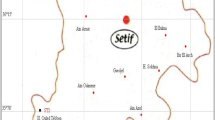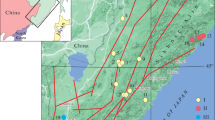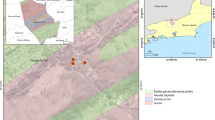Abstract
Activity concentrations of natural radionuclides were determined in water from 31 springs of Sverdlovsk region, Middle Urals, Russia. Activity concentrations of 222Rn varied from 2.4 to 161 Bq L−1 providing the average annual internal dose exposure of 0.27 mSv. The maximal 238U and 232Th activities were 0.124 Bq L−1 and 0.005 Bq L−1 respectively resulting in insignificant risk. No correlation between activities of 222Rn and 232Th or 238U were found. Activity concentrations of 226Ra determined in seven springs with the highest radon content varied from 0.1 to 0.87 mBq L−1 providing annual doses of 0.02–0.18 µSv y−1.




Similar content being viewed by others
References
Iličić D, Palijan G (2019) Persistence of coliform bacteria in spring water microcosms. Hrvatske Vode 27(109):193–200
Idrissova GZ, Akhmedenov KM, Sergeeva IV, Ponomareva AL, Sergeeva ES (2017) Monitoring studies of the ecological state of springs in the Aktobe region in Western Kazakhstan. J Pharm Sci Res 9(7):1122–1127
Jawadi HA, Malistani HA, Moheghy MA, Sagin J (2021) Essential trace elements and arsenic in thermal springs, Afghanistan. Water (Switzerland) 13(2):134
Ulniković VP, Kurilić SM (2020) Heavy metal and metalloid contamination and health risk assessment in spring water on the territory of Belgrade City, Serbia. Environ Geochem Health 42(11):3731–3751
Ghobadi A, Cheraghi M, Sobhanardakani S, Lorestani B, Merrikhpour H (2020) Hydrogeochemical characteristics, temporal, and spatial variations for evaluation of groundwater quality of Hamedan-Bahar Plain as a major agricultural region, West of Iran. Environ Earth Sci 79(18):428
Capraro F, Bizzotto A, Masiol M, Pavoni B (2011) Chemical analyses of spring waters and factor analysis to monitor the functioning of a karstic system. The role of precipitations regimen and anthropic pressures. J Environ Monitor 13(9):2543–2549
Erden PE, Dirican A, Seferinoğlu M, Yeltepe E, Şahin NK (2014) 238U, 234U and 226Ra concentrations in mineral waters and their contribution to the annual committed effective dose in Turkey. J Radioanal Nucl Chem 301:159–166
Chau ND, Michalec B (2009) Natural radioactivity in bottled natural spring, mineral and therapeutic waters in Poland. J Radioanal Nucl Chem 279:121–129
Singla AK, Kansal S, Mehra R (2021) Quantification of radon contamination in drinking water of Rajasthan, India. J Radioanal Nucl Chem 327:1149–1157
Nazir S, Simnani S, Sahoo BK, Mishra R, Sharma T, Masood S (2020) Monitoring geothermal springs and groundwater of Pir Panjal, Jammu and Kashmir, for radon contamination. J Radioanal Nucl Chem 326:1915–1923
Jobbágy V, Altzitzoglou T, Malo P, Tanner V, Hult M (2017) A brief overview on radon measurements in drinking water. J Environ Radioactiv 173:18–24
United States Environmental Protection Agency (US EPA) (1991) Radon measurement proficiency (RMP) program handbook. EPA 520/1-91-006. Office of Radiation Programs, Washington
SanPiN 2.6.1.2523-09 (2010) “Normy radiatsionnoy bezopasnosti (NRB-99/2009)”. [“Radiation safety norms” (NRB-99/2009)]. M.: Energoatomizdat (in Russian)
DNAOP-97. NRBU-97/D 2000 (DNAOP 0.03-3.24-97 (DGN 6.6.1-6.5.061-98)) Normi radiatsionnoy bezpeki Ukraini [Norms of radiation safety in Ukraine] (NRBU-97). https://dnaop.com/html/43243/doc-%D0%94%D0%9D%D0%90%D0%9E%D0%9F_-97/. Accessed 02 March 2021 (in Ukrainian)
European Commission. Council Directive 2013/51/EURATOM of 22 October 2013 (2013) Laying down requirements for the protection of the health of the general public with regard to radioactive substances in water intended for human consumption. https://eur-lex.europa.eu/legal-content/EN/TXT/PDF/?uri=CELEX:32013L0051&rid=7. Accessed 02 March 2021
World Health Organization. Guidelines for Safe Drinking-Water Quality; Fourth Edition 2011. http://apps.who.int/iris/bitstream/10665/44584/1/9789241548151_eng.pdf. Accessed 02 March 2021
Australian Drinking Water Guidelines 6 (2011) Version 3.5 Updated August 2018. https://www.nhmrc.gov.au/about-us/publications/australian-drinking-water-guidelines. Accessed 02 March 2021
Kasić A, Kasumović A, Adrović F, Hodžić M (2016) Radon measurements in well and spring water of the Tuzla area, Bosnia and Herzegovina. Arh Hig Rada Toksikol 67:332–339
Smith L, Voutchkov M (2017) Assessment of radon levels in drinking water wells in St Catherine Jamaica. J Health Pollut 7(16):31–37
State Reports of the Ministry of Ecology and Natural Resources of Sverdlovsk Region https://mprso.midural.ru/article/show/id/1126. Accessed 23 March 2021 (in Russian)
Semenishchev VS, Betenekov ND, Tomashova LA, Voronina AV (2017) Determination of Ra-224 and Ra-226 in drinking waters. AIP Conf Proc 1886(1):020061
Surbeck H (2000) Alpha spectrometry sample preparation using selectively adsorbing thin films. Appl Radiat Isot 53:97–100
Nucfilm Discs website. http://www.nucfilm.ch/nucfilm_discs.html. Accessed 07 June 2021
ICRP Compendium of dose coefficients based on ICRP Publication 60 ICRP Publication 119, Ann. ICRP, 41, Elsevier (2012)
Girault F, Perrier F, Przylibski TA (2016) Radon-222 and radium-226 occurrence in water: a review. Geol Soc Lond Special Publ 451(1):131–154
Acknowledgements
The reported study was funded by RFBR and Sverdlovsk region, Project No. 20-43-660055.
Author information
Authors and Affiliations
Corresponding author
Additional information
Publisher's Note
Springer Nature remains neutral with regard to jurisdictional claims in published maps and institutional affiliations.
Rights and permissions
About this article
Cite this article
Semenishchev, V.S., Voronina, A.V., Titova, S.M. et al. Natural radioactivity in springs of Sverdlovsk region, Middle Urals, Russia. J Radioanal Nucl Chem 329, 857–863 (2021). https://doi.org/10.1007/s10967-021-07847-0
Received:
Accepted:
Published:
Issue Date:
DOI: https://doi.org/10.1007/s10967-021-07847-0




